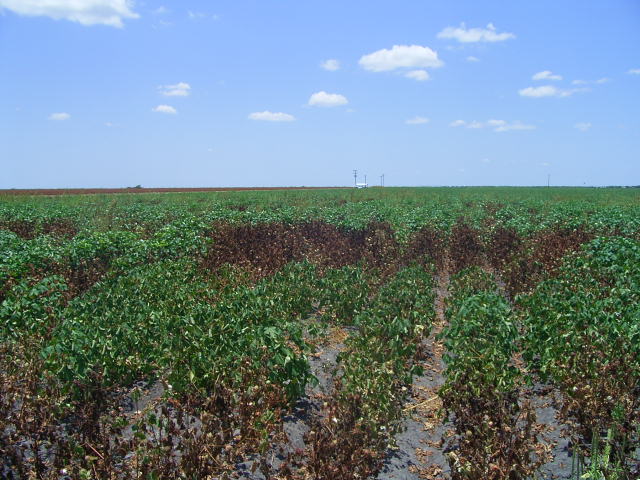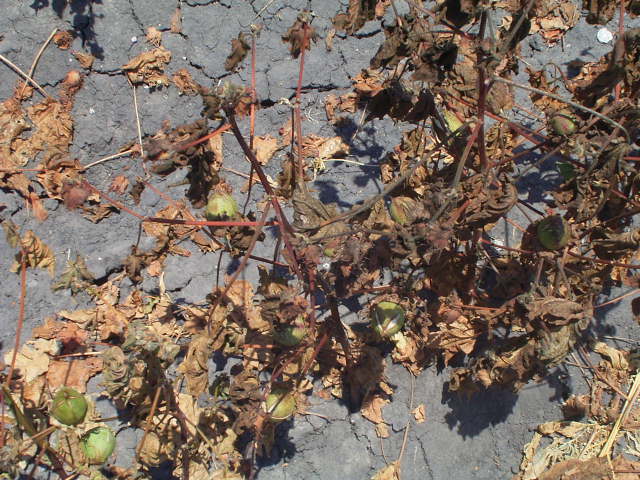
Texas root rot
| Primefact number | Edition | Published | Author |
|---|---|---|---|
| 1405 | First | May 2015 | Plant Biosecurity and Product Integrity |


Texas root rot (Phymatotrichopsis omnivorum) is an exotic plant pest not present in Australia. This disease is a serious threat to Australian agriculture including cotton, grape, nut, citrus and stone fruit industries.
Texas root rot infects the roots of plants, causing sudden and severe wilting of the whole plant. Affected areas of an infected field often appear as circular patterns of dead plants, resembling lightning strike damage but which gradually spread outwards as the fungus spreads through the soil from plant to plant (Figure 1).
There is no known treatment for Texas root rot and once it is established in soil the fungus is able to survive without a host plant for more than 5 years.
Notifiable status
Texas root rot (Phymatotrichopsis omnivorum) is a notifiable plant disease in NSW.
All notifiable plant pests and diseases must be reported within 1 working day. You can report notifiable plant pests and diseases by one of the following methods:
- Call the Exotic Plant Pest Hotline 1800 084 881
- Email biosecurity@dpi.nsw.gov.au with a clear photo and your contact details
- Complete an online form
A full list of notifiable plant pests and diseases can be found in Schedule 2 of the NSW Biosecurity Act 2015.
Description
The first symptoms of Texas root rot appear with increasing temperatures in summer when a sudden wilting of the plant occurs. Wilting may or may not be preceded by the discolouration of leaves to yellow or bronze.
By the time wilting occurs, roots are usually extensively invaded by the fungus. Internal discoloration of cut roots and lower stems can often be found in infected plants.
Shortly after initial wilting, leaves become permanently wilted and die, generally remaining attached to the plant. Infected field crops and vegetable plants die suddenly (Figure 2). Trees and shrubs may die more slowly.
Damage
Texas root rot causes the most damage in cotton crops. Cotton plants infected with Texas root rot are subject to sudden, severe wilting and often death before reaching maturity. Infected plants that manage to survive until harvest produce poor quality fruit. In orchards, tree death may occur more slowly. Losses of established trees in an orchard have been reported to exceed 50%.
Lifecycle
The Texas root rot fungus grows through the soil until it comes in contact with roots of susceptible host plant. The fungus destroys the root cortex (bark) and enters the root to obtain nutrients from the plant. Growth of the fungus inside plant roots and stems blocks the supply of water to the plant.
Following the death of the plant, storage bodies (sclerotia) are formed by the fungus and act as food reserves to sustain Texas root rot until another susceptible host crop is planted or an alternative host is found. Sclerotia can enable Texas root rot to survive in fallow soil, or amongst non-host species for several years.
Host range
The extensive host range of Texas root rot includes more than 2000 species of plants.
Cotton is a preferred host though the fungus will also develop on a number of other commercial field crops, vegetable crops, fruit, ornamental and forest trees and weeds.
Spread
Texas root rot is spread over long distances in contaminated soil. Contaminated soil can be carried on the roots of host plants, boots and clothing, vehicles, machinery and equipment.
Natural spread of Texas root rot is a relatively slow process via the growth of the fungus through the soil from one host plant to another. Dispersal of the fungus can be aided by farm activities moving infected soil, or by loose soil carried in rain runoff.
Distribution
Texas root rot originated in Mexico and south-west USA. The fungus has since spread to Brazil and Venezuela in South America, and Libya in north Africa.
Actions to minimise risk
Put in place biosecurity best practice actions to prevent entry, establishment and spread of pests and diseases:
- practice “Come clean, Go clean”
- ensure all staff and visitors are instructed in and adhere to your business management hygiene requirements
- monitor your crop regularly
- keep records

